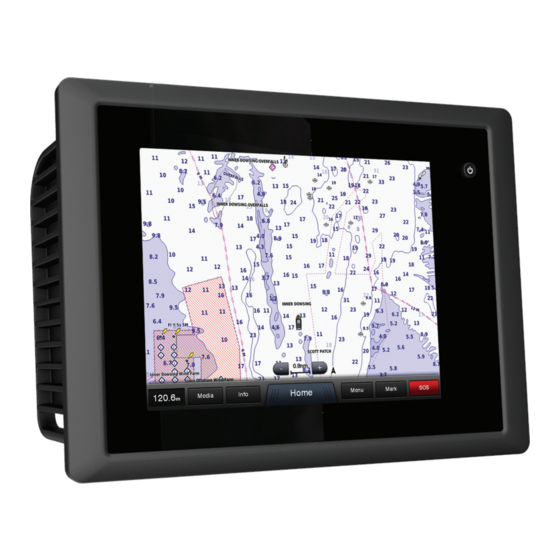Garmin GPSMAP 8530 Black Box 소유자 매뉴얼 - 페이지 30
{카테고리_이름} Garmin GPSMAP 8530 Black Box에 대한 소유자 매뉴얼을 온라인으로 검색하거나 PDF를 다운로드하세요. Garmin GPSMAP 8530 Black Box 36 페이지. Quick start manual
Garmin GPSMAP 8530 Black Box에 대해서도 마찬가지입니다: 사용 설명서 (12 페이지), 빠른 시작 매뉴얼 (4 페이지)

Waypoint IDs: Sets the device to transmit waypoint names or
numbers via NMEA 0183 while navigating. Using numbers
may resolve compatibility issues with older NMEA 0183
autopilots.
Defaults: Restores the NMEA 0183 settings to the original
factory defaults.
Diagnostics: Displays NMEA 0183 diagnostic information.
Configuring NMEA 0183 Output Sentences
You can enable and disable NMEA 0183 output sentences.
1
Select Settings > Communications > NMEA 0183 Setup >
Output Sentences.
2
Select an option.
3
Select one or more NMEA 0183 output sentences, and
select Back.
4
Repeat steps 2 and 3 to enable or disable additional output
sentences.
Setting the Communication Format for Each NMEA 0183
Port
You can configure the communication format for each internal
NMEA 0183 port when connecting your chartplotter to external
NMEA 0183 devices, a computer, or other Garmin devices.
1
Select Settings > Communications > NMEA 0183 Setup >
Port Type.
2
Select an input or output port.
3
Select a format:
• To support the input or output of standard NMEA 0183
data, DSC, and sonar NMEA input support for the DPT,
MTW, and VHW sentences, select NMEA Std..
• To support the input or output of standard NMEA 0183
data for most AIS receivers, select NMEA High Speed.
• To support the input or output of Garmin proprietary data
for interfacing with Garmin software, select Garmin.
4
Repeat steps 2–3 to configure additional input or output
ports.
NMEA 2000 Settings
Select Settings > Communications > NMEA 2000.
Device List: Displays the devices connected to the network.
Label Devices: Changes the labels for available connected
devices.
Garmin Marine Network
The Garmin Marine Network allows you to share data from
Garmin peripheral devices with Garmin chartplotters quickly and
easily. You can connect a chartplotter to a Garmin Marine
Network to receive data from and share data with other Marine
Network-compatible devices and chartplotters.
Setting Alarms
Navigation Alarms
Select Settings > Alarms > Navigation.
Arrival: Sets an alarm to sound when you are within a specified
distance or time from a turn or a destination.
Anchor Drag: Sets an alarm to sound when you exceed a
specified drift distance while anchored.
Off Course: Sets an alarm to sound when you are off course by
a specified distance.
System Alarms
Alarm Clock: Sets an alarm clock.
Device Voltage: Sets an alarm to sound when the battery
reaches a specified low voltage.
GPS Accuracy: Sets an alarm to sound when the GPS location
accuracy falls outside the user-defined value.
24
Setting the Fuel Alarm
Before you can set a fuel level alarm, a compatible fuel flow
sensor must be connected to the NMEA 2000 network.
You can set an alarm to sound when the total amount of
remaining onboard fuel reaches the level you specify.
1
Select Settings > Alarms > Fuel > Fuel Alarm > On.
2
Enter the remaining amount of fuel that triggers the alarm.
Setting Weather Alarms
Before you can set weather alarms, you must have a
compatible chartplotter connected to a weather device, such as
a GXM™ device, and have a valid weather subscription.
1
Select Settings > Alarms > Weather.
2
Turn on alarms for specific weather events.
My Vessel Settings
NOTE: Some settings and options require additional charts or
hardware.
Select Settings > My Vessel.
Keel Offset: Offsets the surface reading for the depth of a keel,
making it possible to measure depth from the bottom of the
keel instead of from the transducer location
Temperature Offset: Compensates for the water temperature
reading from a NMEA 0183 water-temperature sensor or a
temperature-capable transducer
Calibrate Water Speed: Calibrates the speed-sensing
transducer or sensor
(page
Fuel Capacity: Sets the combined fuel capacity of all the fuel
tanks on your vessel
(page
Fill Up All Tanks: Sets the tank levels to full
Add Fuel to Boat: Allows you to enter the quantity of fuel you
added to your tank, when you did not entirely fill up the tank
(page
17).
Set Total Fuel Onboard: Sets the combined amount of fuel in
all the fuel tanks on your vessel
Set Gauge Limits: Sets the upper and lower limits of various
gauges
(page
17).
Setting the Keel Offset
You can enter a keel offset to compensate the surface reading
for the depth of a keel, making it possible to measure depth
from the bottom of the keel instead of from the transducer
location. Enter a positive number to offset for a keel. You can
enter a negative number to compensate for a large vessel that
may draw several feet of water.
1
Complete an action, based on the location of the transducer:
• If the transducer is installed at the water line
the distance from the transducer location to the keel of the
boat. Enter this value in step 3 and 4 as a positive
number.
• If the transducer is installed at the bottom of the keel
measure the distance from the transducer to the water
line. Enter this value in step 3 and 4 as a negative
number.
(page
24).
(page
25).
25).
17).
(page
17).
(page
17).
, measure
Device Configuration
,
